THE LAND OF UPRIGHT PEOPLEBurkina Faso is a
landlocked nation in West Africa. It is surrounded by six
countries: Mali to the north, Niger to the east, Benin to
the south east, Togo and Ghana to the south, and Côte
d'Ivoire to the south west.
A 2002 estimate of Burkina Faso's population came in at
12,603,185. Its inhabitants are known as Burkinabè.
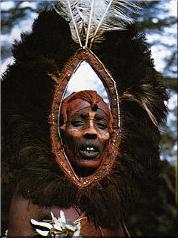
Formerly the Republic of Upper Volta, it was renamed on
August 4, 1984 by President Thomas Sankara to mean "the land
of upright people" (or "upright land") in Mossi and Dioula,
the major native languages of the country.
A impoverished country, several hundred thousand farm
workers migrate south every year to Côte d'Ivoire and Ghana
in search of paid labour.
Trivia & Quick Points:
-
Burkina Faso, formerly Upper Volta, is a landlocked
country in West Africa.
-
Burkina is ranked one of the poorest countries in the
world and also as the most illiterate.
-
Burkina is an excellent destination for anyone
interested in seeing beautiful West African country and
exploring African culture and music.
Facts & Information:
History
Like all of the west of Africa, Burkina Faso was populated
early, notably by hunter-gatherers in the northwestern part
of the country (12,000 to 5000 BC), and whose tools
(scrapers, chisels and arrowheads) were discovered in 1973.
Settlements appeared between 3600 and 2600 BC with farmers,
the traces of whose structures leave the impression of
relatively permanent buildings.
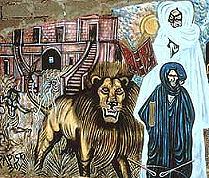
The use of iron, ceramics and polished stone developed
between 1500 and 1000 BC, as well as a preoccupation with
spiritual matters, as shown by the burial remains which have
been discovered.
Relics of the Dogon are found in the centre-north, north and
north west region. They left the area between the 15th and
16th centuries BC to settle in the cliffs of Bandiagara.
Elsewhere, the remains of high walls are localised in the
southwest of Burkina Faso (as well as in the Côte d'Ivoire),
but the people who built them have not yet been definitely
identified.
Burkina Faso was a very important economic region for the
Songhai Empire during the 15th and 16th centuries. From
colony to independence In 1896, the Mossi kingdom of
Ouagadougou became a French protectorate after being
defeated by French forces. In 1898, the majority of the
region corresponding to Burkina Faso today was conquered.
In 1904, these territories were integrated into French West
Africa in the heart of the Upper-Senegal-Niger (Haut-Sénégal-Niger)
colony. Its inhabitants participated in the First World War
in the heart of the battalions of the Senegalese Infantry (Tirailleurs
sénégalais).
It was originally administered as part of Côte d'Ivoire
colony, but became a separate colony in 1919. On March 1,
1919, François Charles Alexis Édouard Hesling became the
first governor of the new colony of Upper-Volta, which was
broken up September 5, 1932, being shared between the Côte
d’Ivoire, Mali and Niger.
On September 4, 1947 Upper-Volta was recreated with its 1932
boundaries. On December 11, 1958, it achieved
self-government, and became a republic and member of the
Franco-African Community (La Communauté Franco-Africaine).
Full independence was attained in 1960. The country's first
military coup occurred in 1966; it returned to civilian rule
in 1978. There was another coup, led by Saye Zerbo in 1980,
which in turn was overthrown in 1982. A counter-coup was
launched in 1983, which left Captain Thomas Sankara in
charge.
Politics
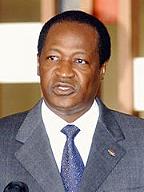
Burkina Faso President Blaise Compaoré
The current president is Blaise Compaoré, who came to power
in 1987 after a coup d'état that killed Thomas Sankara.
The constitution of June 2, 1991, established a
semi-presidential government with a parliament (Assemblée)
which can be dissolved by the President of the Republic, who
is elected for a term of 5 years. The year 2000 saw a
constitutional amendment reducing the presidential term from
7 to 5 years, which was enforced during the 2005 elections.
- The parliament consists of two chambers: the lower house (l'Assemblée
Nationale) and the upper house (la Chambre des Représentants).
There is also a constitutional chamber, composed of ten
members, and an economic and social council whose roles are
purely consultative.
- The administrative divisions of Burkina Faso are divided
into 13 regions, 45 provinces, and 301 departments.
Culture
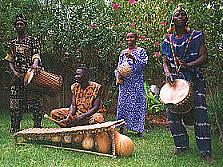
Probably the thing Burkina Faso is most famous for is its
music and drumming culture. What a great country to visit if
you are interested in learning West African drumming!
As with music, art is also part of the culture of Burkina
Faso.
The country hosts the International Arts and Crafts Fair,
Ouagadougou, better known by its French name as SIAO,
Le Salon International de L'Artisanat de Ouagadougou,
one of the most important African handicraft fairs in the
world.
Climate
Burkina Faso has a primarily tropical climate with two very
distinct seasons: the rainy season with between 24-35 inches
(600 and 900 mm) of rainfall, and the dry season during
which the harmattan blows, a hot dry wind from the Sahara.
The rainy season lasts approximately 4 months, May/ June to
September, and is shorter in the north of the country.
Geography
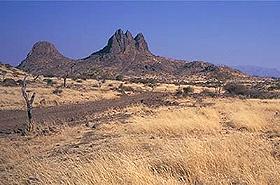
The average altitude is 400 metres (1,300 ft) and the
difference between the highest and lowest terrain is no
greater than 600 metres (2,000 ft). Burkina Faso is
therefore a relatively flat country, with a very few
localised exceptions.
Burkina Faso is made up of two major types of countryside:
-The larger part of the country is covered by a peneplain
which forms a gently undulating landscape with, in some
areas, a few isolated hills, the last vestiges of a
precambrian massif.
- The south-west of the country forms a sandstone massif,
where the highest peak is found: Ténakourou (749 m, 2,450
ft). The massif is bordered by sheer cliffs up to 150 metres
(490 ft.) high.
Hydrography
The country owed its former name of Upper Volta to three
rivers which cross it: le Mouhoun (formerly called the Black
Volta), le Nakambé (the White Volta) and le Nazinon (the Red
Volta).
Le Mouhoun, along with la Comoé which flows to the south
west, is the country's only river which flows year-round.
The basin of the Niger River also drains 27% of the
country's surface. Its tributaries (le Béli, le Gorouol, le
Goudébo and le Dargol) are seasonal streams, and only flow
for 4 to 6 months a year but can cause large floods.
The country also contains numerous lakes. The principal
lakes are Tingrela, Bam and Dem, and the large ponds of
Oursi, Béli, Yomboli, and Markoye.
Water shortages are often a problem, especially in the north
of the country.
Economy
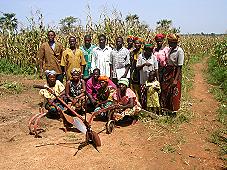
One of the poorest countries in the world, landlocked
Burkina Faso has a high population density, few natural
resources, and a fragile soil.
It is ranked as the 28th poorest nation, among other nations
such as the Republic of the Congo and Tajikistan,
represented numerically in its low GDP per capita income of
$1,300.
This can be explained by its population growth and its arid
soil. About 90% of the population is engaged in (mainly
subsistence) agriculture, which is highly vulnerable to
variations in rainfall.
Agriculture represents 32% of its gross domestic product and
occupies 80% of the working population. It consists mostly
of livestock but also, especially in the south and
southwest, of growing sorghum, millet, maize (corn),
peanuts, rice, and cotton.
Industry remains dominated by unprofitable
government-controlled corporations, most specifically in its
mineral exploitation of copper, iron, manganese, and, above
all, gold. The effects are corruption and financial
disparity. (The rich getting richer and the poor getting
poorer)
A large part of the economic activity of the country is
funded by international aid.
Lack of work causes a high rate of emigration: for example,
three million people from Burkina Faso live in Côte
d'Ivoire. According to the Central Bank of Western African
States (La Banque Centrale des États de l'Afrique de l'Ouest),
these migrants send tens of billions of CFA francs back to
Burkina Faso each year.
Demographics
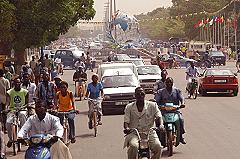
United Nations Square in Ouagadougou, Burkina Faso
Burkina Faso has an estimated life expectancy at birth of
slightly under 50 years of age. The median age of its
inhabitants is under 17.
The Population growth rate is 2.71% (2000 est.)
Population estimates take into account the effects of excess
mortality due to AIDS; this can result in lower life
expectancy, higher infant mortality and death rates, lower
population and growth rates, and changes in the distribution
of population by age and sex than would otherwise be
expected.
The July 2000 estimated 11,946,065 Burkinabè belong to two
major West African cultural groups-the Voltaic and the Mande.
The Voltaic are far more numerous and include the Mossi, who
make up about one-half of the population. Additionally,
about 5,000 Europeans live in Burkina Faso.
The population is concentrated in the south and center of
the country, sometimes exceeding 48 per square kilometer
(125/sq.mi). This high population density, causes annual
migrations of hundreds of thousands, for seasonal
employment.
Approximately 50% of the population is Muslim; Christians
account for about 30%, and followers of traditional African
religions (typically animism of various forms) make up about
20%. Many Christians and Muslims incorporate elements of
animism into their religious practices.
 Au
coeur de La Gacilly, Village des Métiers d'Arts, Que Jean
Claude MAHE, a créé il y a plus de 25 ans LE MONDE DES
GIROUETTES LUMINAIRES ENSEIGNES
Au
coeur de La Gacilly, Village des Métiers d'Arts, Que Jean
Claude MAHE, a créé il y a plus de 25 ans LE MONDE DES
GIROUETTES LUMINAIRES ENSEIGNES
LE MONDE DES GIROUETTES et
COMPAGNIE est le lieu dédié aux silhouettes pour la
décoration. Cet espace de vente propose des produits
spécialement créés et fabriqués pour vous. Aujourd’hui, nous
sommes à la recherche de produits authentiques. Fort de ce
constat et conscient que tout le monde n'a véritablement pas
le temps de chercher pour acheter ce type de produits. Nous
avons rassemblé, au sein de notre catalogue, des images et
silhouettes, déclinées en plein de produits originaux.
LE MONDE DES GIROUETTES apporte un contenu, fonctionnel,
simple et pratique, découpé en plusieurs espaces : produits
pour trouver et sélectionner simplement et rapidement.
LE MONDE DES GIROUETTES et COMPAGNIE : 26 rue St Vincent
56200 la Gacilly Tel : 02 99 08 55 13
La Gacilly Cité des Métiers d’Art Les premiers artisans
d'art se sont implantés en 1970 dans le village de La
Gacilly. Ainsi au fil du temps, La Gacilly a acquis une
notoriété dans l'accueil des professionnels des Métiers
d'Art.

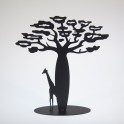
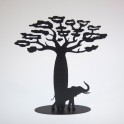
L'arbre à bijoux Baobab Girafe est en métal acier de 2
mm.Modèle avec finition noir matTaille : 30 cm ou 40 cm de
haut.Son dessin donne des possibilités infinies de ranger
vos bijoux, nous l'avons concu pour cela....
http://www.jouvenaud.com/arbre-a-bijoux.html
http://www.bozea.com/decoration-maison/artisans/accessoire-decoration-jardin-atelier-jouvenaud/ui=m66
JUMELAGE 1980 DIAPAGA BURKINA FASO ET LA GACILLY FRANCE
ECOGUIDES OF THE WAFP PARKS - ASSOCIATION OF TOURIST
ECOGUIDES/ECOSYSTEM PROTECTION BURKINA FASO, NIGER ET BENIN

The lovely bush camp at Point-Triple
A Burkina Faso, nous vous recommandons :
The Hotel Le Gacilien is on the main street a few blocks
from the Ougapo.
It is named for the town of La Gacilly in Brittany,
France, Diapaga's sister city.
4 rooms in the main building, plus both cases and
Gourmantché-style huts in the back courtyard. Phone +226 40
79 10 18
- Double hut with fan, separate WC: 3,500 FCFA.
- En suite, 4,000 FCFA. Double room with fan 7,000
FCFA;air-conditioned 10,000 FCFA
- Restaurant Bahanma : breakfast 800 FCFA.
“Notre désir le plus cher depuis 34 ans. Vous donner du
bonheur” Sylvie LOMPO
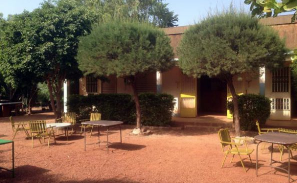
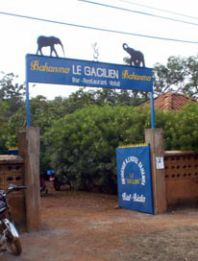
DISCOVERING RANCH DE NAZINGA,
BURKINA FASO
August 18, 2013
VENTURES AFRICA – The Nazinga Ranch extends over 100,000
hectares and includes nearly 600 km of slopes. Nazinga
is a very special type of protected area, hunting area
and tourism of 97,000ha for hunting and 20,000ha for
safaris lovers.
Established by Robert and Lark Lungren, two
Canadian brothers who grew in the country,
Nazinga is a beautiful ranch with an open and a
close forest, where only crop areas demarcate
the territory. Many facilities were created on
sight to better manage the ranch’s biodiversity.
The Nazinga Ranch, is a protected area of 913
km2, located near Po in southern Burkina Faso.
To combat the cyclical drought, deforestation,
overgrazing, burning, soil fatigue and other
devastating impact of heat on nature, the
Lungren brothers decided, back in the days, to
introduce a new concept at the time for West
Africa, which led to the introduction of a ranch
that will later combine eco tourism vision and
controlled hunting. Since then, the ranch has
been a very busy place: contributing to economic
development of Burkina Faso.
The Nazinga ranch has driven masses to its three
main areas: a conservation area of 84.5 km2, a
buffer area of 48.3 km2 and a hunting area of
789.6 km2, as well as some hunting areas. The
ranch also attracts additional tourists to its
classified forest of Sissili (327 km2), which is
another hunting spot. Then, there is the Kaboré
Tambi National Park, another national park of
Burkina Faso situated between Ouagadougou and
the border of Ghana which has a much richer
fauna and follows the course of the Nazinon
River.
This under-protection ranch has grown
considerably and today is 94,000 hectares
containing more than 20,000 animals, including
800 elephants which remain the animals per
excellence in this region of West Africa.
Nazinga Ranch has 39 species of mammal,
including thousands of antelope such as roan
antelope, waterbuck, oribi, and reedbuck. In
1988, 8 Buffon’s kob were introduced to the
park, plus the 500 buffalo, the 5,000 warthog,
crocodile and many other primates including
baboons, vervet and patas. The Nazinga ranch
also has 275 species of bird including
hornbills, hawk and herons.
Just before you start planning a getaway to this
part of West Africa, keep in mind that Burkina
Faso is a Sahelian country, so the focus should
be lightweight clothing and cotton clothing.
However, the weather could cool down during
evenings, so visitors should plan to bring a
sweater and long pants to protect themselves
against mosquitoes.
Staying in the village of Zigla or Boala is a
great idea because you will be pampered by the
villagers. Learning local traditions and customs
will be the best way to get to know their
culture and exchange with the people who live in
the heart of a great game reserve known as
Nazinga.

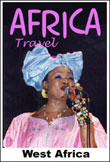







 Au
coeur de La Gacilly, Village des Métiers d'Arts, Que Jean
Claude MAHE, a créé il y a plus de 25 ans LE MONDE DES
GIROUETTES LUMINAIRES ENSEIGNES
Au
coeur de La Gacilly, Village des Métiers d'Arts, Que Jean
Claude MAHE, a créé il y a plus de 25 ans LE MONDE DES
GIROUETTES LUMINAIRES ENSEIGNES




